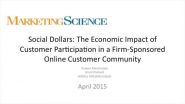INFORMATION:
About ISMS
The authors of the study are members of ISMS, the INFORMS Society for Marketing Science. ISMS is a group of scholars focused on describing, explaining, and predicting market phenomena at the interface of firms and consumers.
This press release was prepared by the authors created by the authors with the assistance of Gerard Tellis, ISMS VP of External Affairs.
About INFORMS
INFORMS is the leading international association for professionals in analytics and operations research (O.R.). INFORMS advances research, and develops and promotes best practices in analytics and O.R. through collaboration, knowledge sharing, and professional development. INFORMS helps business, government, and other organization professionals make better decisions to drive value to their organizations and society. Our certification program (CAP®), highly cited publications, educational meetings and conferences, continuing education, industry and process focused networking communities, competitions, and recognition provide professionals with the knowledge and connections they need to achieve ever greater value for their organizations. Further information about INFORMS, analytics, and operations research is at http://www.informs.org or @informs.
INFORMS journal study finds double-digit growth for firms creating own online communities
2015-05-04
(Press-News.org) A new study published in Marketing Science, a journal of the Institute for Operations Research and the Management Sciences (INFORMS), shows double-digit revenue growth for firms that create their own brand-specific online communities.
The study, Social Dollars: The Economic Impact of Customer Participation in a Firm-Sponsored Online Customer Community, is by professors Puneet Manchanda of the University of Michigan, Grant Packard of Wilfrid Laurier University, and Adithya Pattabhiramaiah of the Georgia Institute of Technology.
Engaging consumers through online social networks is an increasingly mission-critical activity for major brands. While some firms host their own brand-centric online communities, Facebook has become the dominant host for online communities of brand enthusiasts, taking over $10 billion and 10% of U.S. digital advertising spending in 2014. But do firms see real economic returns by enabling their own customer communities? And if so, what is it about one's own online community that drives these returns?
Watch an interview with Prof. Manchanda at https://youtu.be/caYmJxam3Ug.
This study investigates this question by looking for "Social Dollars" - economic returns to firms from customers that can be attributed to the act of joining firm-specific online communities. The results of the study offer the first hard evidence that these social dollars exist. Specifically, they account for almost 20% of all dollars spent by customers after they join the community, representing a significant additional benefit. The study reveals that the key to achieving these returns is not so much the customer's increased exposure to relevant brand or product information as it is enabling social engagement among consumers over their shared brand or product interests (for example, creating "friend" ties and "posting" to one another).
"While many firms think of enabling online customer communities as just a form of advertising, we reveal that supporting consumer social interactions can generate a substantial direct revenue benefit to the firm on their own," said study co-author Puneet Manchanda.
Armed with a unique data set--consumer panel data from a large multi-category, multi-channel retailer for a fifteen-month period before and after the launch of the retailer's online community--the researchers were able to isolate how much of the post-launch revenue from customers was attributable just to their joining and participating in the online community. The firm's online community allowed consumers to create friend ties, talk about, "like," or recommend products, and create special-interest group pages. The researchers ran many robustness tests to assess the strength of a causal linkage, all of which supported the validity of their findings.
The big question for companies, of course, is whether these additional social dollars outweigh the cost of setting up and maintaining one's own online community. Using confidential data from the retailer, the researchers estimate that the firm achieved break-even on its investment within months of launching the community.
"While not all firms may achieve the same level of economic returns, firm-sponsored communities can be valuable on other dimensions," says Manchanda. "The ability to design the community's features and observe customer behavior is preferable to ceding control and insight of a brand's online social network to a third party like Facebook. Of course, such communities will never draw the volume of traffic that sites like Facebook get. However, they are likely to get a much higher quality of traffic driven in no small part by the user-generated content from the community. This traffic leads to better organic searches."
(Organic searches are online searches on keywords that do not generate paid advertisements.)
ELSE PRESS RELEASES FROM THIS DATE:
These gigantic whales have nerves like bungee cords
2015-05-04
Nerves aren't known for being stretchy. In fact, "nerve stretch injury" is a common form of trauma in humans. But researchers reporting in the Cell Press journal Current Biology on May 4 have discovered that nerves in the mouths and tongues of rorqual whales can more than double their length with no trouble at all.
"These large nerves actually stretch and recoil like bungee cords," says A. Wayne Vogl of the University of British Columbia. "This is unlike other nerves in vertebrates, where the nerve is of a more fixed length that has enough slack in it to accommodate changes ...
Gigantic whales have stretchy 'bungee cord' nerves
2015-05-04
University of British Columbia (UBC) researchers have discovered a unique nerve structure in the mouth and tongue of rorqual whales that can double in length and then recoil like a bungee cord.
The stretchy nerves explain how the massive whales are able to balloon an immense pocket between their body wall and overlying blubber to capture prey during feeding dives.
"This discovery was totally unexpected and unlike other nerve structures we've seen in vertebrates, which are of a more fixed length," says Wayne Vogl of UBC's Cellular and Physiological Sciences department.
"The ...
Emergency department opioid prescribing
2015-05-04
BOSTON, MA - The Emergency Department (ED) is at the convergence of the opioid epidemic as emergency physicians (EPs) routinely care for patients with adverse effects from opioids, including overdoses and those battling addiction, as well as treating patients that benefit from opioid use. Increasingly, EPs are required to distinguish between patients who are suffering from a condition that warrants opioids to relieve pain, and those who may be attempting to obtain these medications for other purposes, such as abuse or diversion. Overall, opioid pain reliever prescribing ...
Discovery could help reverse glucocorticoid resistance in some young leukemia patients
2015-05-04
(MEMPHIS, Tenn. -- May 4, 2015) Researchers led by St. Jude Children's Research Hospital scientists have identified a mechanism that helps leukemia cells resist glucocorticoids, a finding that lays the foundation for more effective treatment of cancer and possibly a host of autoimmune diseases. The findings appear online today in the scientific journal Nature Genetics.
The research focused on glucocorticoids, a class of steroid hormones. These hormones have been key ingredients in the chemotherapy cocktail that has helped to push long-term survival for the most common ...
Scientists dramatically improve method for finding common genetic alterations in tumors
2015-05-04
(MEMPHIS, Tenn. - May 4, 2015) St. Jude Children's Research Hospital scientists have developed a significantly better computer tool for finding genetic alterations that play an important role in many cancers but were difficult to identify with whole-genome sequencing. The findings appear today in the scientific journal Nature Methods.
The tool is an algorithm called CONSERTING, short for Copy Number Segmentation by Regression Tree in Next Generation Sequencing.
St. Jude researchers created CONSERTING to improve identification of copy number alterations (CNAs) in the ...
Detecting knee-cushion problems early could lead to better treatments
2015-05-04
COLUMBIA, Mo. -- Within the knee, two specialized, C-shaped pads of tissue called menisci perform many functions that are critical to knee-joint health. The menisci, best known as the shock absorbers in the knee, help disperse pressure, reduce friction and nourish the knee. Now, new research from the University of Missouri shows even small changes in the menisci can hinder their ability to perform critical knee functions. The research could provide new approaches to preventing and treating meniscal injuries as well as clues to understanding osteoarthritis; meniscal problems ...
3-D printed trachea among key Mount Sinai research presented at AATS meeting
2015-05-04
(New York -- May 4, 2015) Icahn School of Medicine at Mount Sinai researchers presented several landmark studies at the 2015 American Association for Thoracic Surgery (AATS) meeting in Seattle.
AATS Highlights include:
First Successful 3D Printed Trachea
A team of researchers from Icahn School of Medicine have combined 3D printing technology with human stem cells to create the first successful 3D-printed biologic tracheal graft in an animal model. Using a biocompatible polymer, researchers created a customized 3D-printed tracheal graft seeded with stem cells. The ...
Global decline of large herbivores may lead to an 'empty landscape'
2015-05-04
CORVALLIS, Ore. - The decline of the world's large herbivores, especially in Africa and parts of Asia, is raising the specter of an "empty landscape" in some of the most diverse ecosystems on the planet, according to a newly published study.
Many populations of animals such as rhinoceroses, zebras, camels, elephants and tapirs are diminishing or threatened with extinction in grasslands, savannahs, deserts and forests, scientists say.
An international team of wildlife ecologists led by William Ripple, Oregon State University distinguished professor in the College of ...
Inanimate beads behave in lifelike ways
2015-05-04
Scientists have created microbe-sized beads that can utilize energy in the environment to self-propel upstream by purely physical means.
Life is hard to define, but metabolism, mobility and replication are three commonly agreed elements. The beads are not alive, but they meet two of these three requirements.
"Living systems change their behavior according to their environment," said Jeremie Palacci, a professor of physics at the University of California, San Diego. "So the question was, can we design a particle that can sense its environment with no neural system or ...
Beyond chicken fingers and fries: New evidence in favor of healthier kids' menus
2015-05-04
Contrary to popular belief, more healthy kids' meals were ordered after a regional restaurant chain added more healthy options to its kids' menu and removed soda and fries, researchers from ChildObesity180 at Tufts University Friedman School reported today in the journal Obesity. Including more healthy options on the menu didn't hurt overall restaurant revenue, and may have even supported growth.
Researchers examined outcomes before and after the Silver Diner, a full-service family restaurant chain, made changes to its children's menu in order to make healthier items ...




